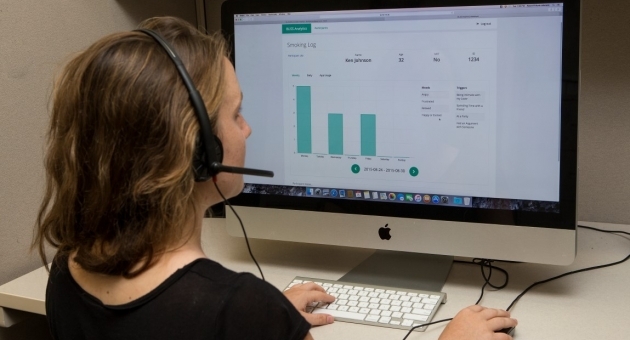App may help protect kids from secondhand smoke

What if an app could help smokers quit and reduce the amount of secondhand smoke exposure to their children?
A new research project, led by College of Public Health Professor Stephen J. Lepore and Associate Professor Bradley N. Collins, is examining this question.
BLiSS (Babies Living Safe and Smokefree), launched in May with the help of a five-year, $2.7 million award from the National Cancer Institute. The program uses traditional telephone counseling, nicotine replacement therapy (NRT) and the team’s newly designed self-help app to protect the population most vulnerable to secondhand smoke.
“The integration of telephone counseling, nicotine replacement and an app maximizes the benefits of traditional counseling,” said Lepore.
The team’s app, based on a model developed by NCI, helps participants track the number of cigarettes smoked per day and pinpoint the situations or moods that trigger their smoking behavior. Counselors can use that information to better tailor their advice to smokers about healthier ways to manage their urges as they try to quit smoking.
“Merging app use with counseling is part of our process we call ‘high tech, warm touch,’” Collins said.
Smoke exposure has been linked to heart disease, lung cancer and stroke in adults and with Sudden Infant Death Syndrome (SIDS), inner ear infections, increased asthma rates and other health problems in youngsters.
One of the greatest public health successes of the past several decades has been the reduction of secondhand smoke exposure. Yet, this threat to health remains a major problem in cities, and in Philadelphia in particular.
“The reality is that while we have seen reduced rates in secondhand smoke exposure, the rate for young children is still very high, especially in low income and minority communities,” Lepore said. “This is a big issue in Philadelphia in communities such as North Philadelphia.”
BLiSS is based on KiSS (Kids Safe and Smokefree), a multilevel intervention model for smoking parents developed by Collins and Lepore in a previous NCI-funded clinical trial. For that study, the team trained pediatric providers to address child cigarette smoke exposure during clinic visits and connect participants to a telebased smoking cessation counseling program. The KiSS program received over 3,000 referrals in two years.
“For KiSS, we helped people connect to smoking cessation support, but we couldn’t provide nicotine replacement therapy and only about 50 percent of participants followed through with obtaining it,” Lepore said.
For the current study, the researchers are able to build on the lessons learned from KiSS.
“We realized that with our target population of smokers who have greater challenges quitting compared to the general population of smokers, it is important to put NRT in people’s hands and build extra guidance in our counseling about its proper use,” said Collins.
BLiSS, still in its preliminary stages, is currently being implemented in a half dozen Women, Infant and Children clinics.
According to Collins and Lepore, BLiSS holds the potential to become a national model for smoking reduction programs.
“Many of these services, such as quitlines or telephone based counseling, exist elsewhere but they are not offered in an integrated way,” Lepore said. “We have high hopes that our approach will be effective and easily replicable elsewhere."
--Elisa Ludwig